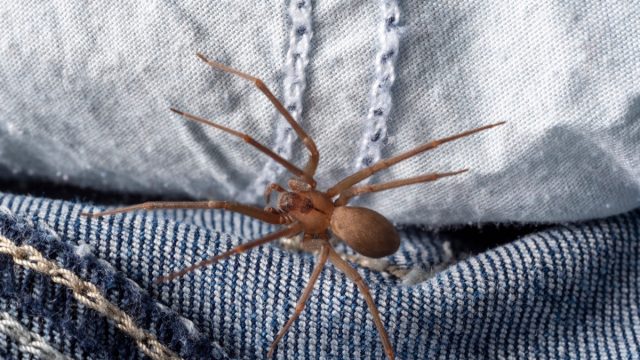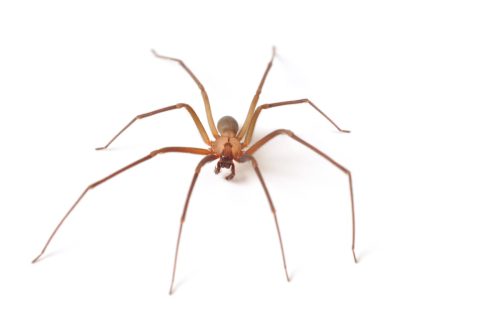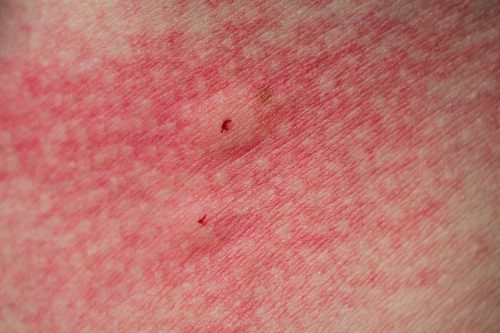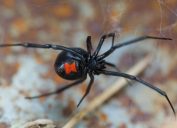Man Nearly Loses Leg to Spider Bite—Watch for These Symptoms, Doctors Warn
He was in the hospital for almost a week after noticing a swollen spot on his leg.

Many of us are spooked enough when we see a harmless spider in our home, so coming face-to-face with a venomous spider is an extra terrifying prospect. The Centers for Disease Control and Prevention (CDC) assures that fatal spider bites are "extremely rare" in the U.S., but that doesn't mean there can't be severe consequences. In fact, one man just learned how serious a spider bite can get, after he nearly lost his leg to a brown recluse bite. Read on to discover the symptoms doctors say you need to watch out for.
RELATED: "Very Large" New Spider Species Discovered—Here's Where There May Be Hiding.
A Georgia man had to be hospitalized following a brown recluse bite.

Gabe Lustman, a pop and R&B singer based in Atlanta, recently spent nearly a week in the hospital as he battled a severe spider bite, CBS News reported. Lustman said he doesn't know when or how he was bitten, but had woken up in "excruciating pain" one day, with a swollen spot on his leg.
"My leg was very sore, and I noticed like a little bite mark but my whole leg was starting to swell up and it was turning red and purplish and like all these nasty colors," he told CBS News, adding he would elevate the leg for a bit of short-lived relief. "[There was] sharp pain shooting down my leg when I would stand up."
RELATED: 9 Cleaning Habits That Attract Spiders.
He almost lost his leg.

Lustman had no idea that the swollen spot on his leg was an urgent medical emergency. He said that he tried brushing off the pain for 48 hours before he decided to go see a doctor—and now he's grateful he didn't wait any longer, CBS News reported.
"I came in at a very, very lucky time," he told the news outlet. "Because if I didn't, I could have lost my leg."
Doctors told Lustman that if he had put off medical attention for another 24 to 48 hours, the infection could have spread to the point of being "uncontrollable," per CBS News. But after a series of antibiotic treatments, Lustman said he is feeling better, despite still having some tenderness in the area where he was bitten.
"I can walk again, but when I touch my leg, if I bump it or something, it's still painful," he said.
RELATED: Black Widow Spiders May Go Extinct—But Venomous Brown Widows Are on the Rise.
Doctors determined that the bite came from a brown recluse.

Although Lustman had no recollection of the actual bite, doctors were able to determine that it came from a brown recluse spider, CBS News reported. This species is "most common in the south and central states" of the U.S., according to Mount Sinai. However, brown recluses have been seen in larger cities outside of these regions.
Adam Friedman, MD, professor and chair of dermatology at the George Washington School of Medicine and Health Sciences, told CBS News that a bite from this venomous spider can be quite dangerous for people of any age—so it's important to recognize what they look like.
"Certainly, identifying the spider is helpful as the brown recluse has a unique appearance, with a yellow to brown color and a fiddle or violin shaped mark on its back," Friedman said, noting that they typically hide in dark, warm, and dry spaces like attics or under wood piles.
RELATED: 7 Places Black Widows Spiders Are Hiding in Your Home.
They say you should be on the lookout for certain symptoms.

Brown recluse spiders aren't quick to bite and typically only do so when threatened. But that doesn't mean you shouldn't be prepared in case one does strike you. "Overall these bites are uncommon but quick medical attention is recommended for all," Friedman told CBS News.
According to the expert, it can be hard to know you've been bitten because you may not feel it at first. "The bite may be painless. However, the patient may develop redness, a blister and eventual tissue death," Friedman explained. "Progressively worsening pain, versus itch and skin breakdown, should also push one to seek care."
Lustman said he eventually experienced the redness extending into steak marks that looked like someone scratched along his leg—which the Mayo Clinic says is a symptom that should prompt immediate medical care.
According to Friedman, other systemic symptoms may include fever, chills, vomiting, joint pain, blood in urine, and possible shock or death.
"Make sure you go to seek professional medical attention, because if I didn't, I could have lost my leg," Lustman said in his interview with CBS News. "This is your body, you need to attend to it and take care of it, because you don't know how serious these things can really get and how how bad it could be—I didn't realize that."
RELATED: For more up-to-date information, sign up for our daily newsletter.





















